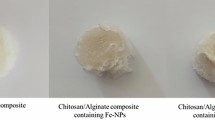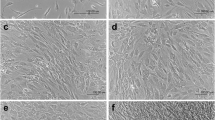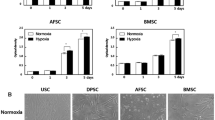Abstract
Mesenchymal stem cells (MSCs) isolated from umbilical card blood were capable of differentiated in to multiple mesenchymal cell lineages. The objective of the current study was to establish a reproducible system for the in vitro osteogenic differentiation of human MSCs, and to characterize the effect of changes in the microenvironment upon differentiation. In our previous studies, MSCs cultured in varying concentrations of L-ascorbic acid (50 μM to 500 μM) had shown the various levels of osteoblast differentiation, as determined by morphology, alkaline phosphatase activity, modulations in osteocalcin mRNA expression, and mineralized extracellular matrix (ECM) deposition holding inorganic hydroxyapatite (HA) and Tricalcium phosphate (TCP). In present study, we noticed a study increase in APase activity up to 250 μM L-ascorbic acid and by end of 16 days, cells gained cuboidal morphology, which is characteristic feature of osteoblasts. The intense sharp difractograms (peaks) between 30°–35° demonstrate the deposition of HA and TCP, which are major inorganic components of bone. The reproducible results of our studies provided a useful model for evaluating the factors responsible for the stepwise progression of cells from undifferentiated precursors to secretary osteoblasts, and eventually terminally differentiated osteocytes.
Similar content being viewed by others
References
TM Temu, KY Wu, PA Gruppuso, et al., The mechanism of ascorbic acid-induced differentiation of ATDC5 chondrogenic cells, Am J Physiol Endocrinol Metab, 299, E325 (2010).
FM Altaf, TM Hering, NH Kazmi, et al., Ascorbate enhanced chondrogenesis of ATDC5 cells, Eur Cell Mater, 12, 64 (2006).
G Xiao, Y Cui, P Ducy, et al., Ascorbic acid-dependent activation of the osteocalcin promoter in MC3T3-E1 preosteoblasts: requirement for collagen matrix synthesis and the presence of an intact OSE2 sequence, Mol Endocrinol, 11, 1103 (1997).
RT Franceschi, JX Wilson, SJ Dixon, Requirement for Na-dependent ascorbic acid transport in osteoblast function, Am J Physiol, 268, C1430 (1995).
MA Aronow, LC Gerstenfeld, TA Owen, Factors that promote progressive development of the osteoblast phenotype in cultured fetal rat calvaria cells, J Cell Physiol, 143, 213 (1990).
RT Franceschi, The role of ascorbic acid in mesenchymal differentiation, Nutr Rev, 50, 65 (1992).
NK Mekala, RR Baadhe, SR Parcha, et al., Enhanced proliferation and osteogenic differentiation of human umbilical cord blood stem cells by L-ascorbic acid, in vitro, Curr Stem Cell Res Ther, 8, 156 (2013).
DM Piscopo, EB Johansen, R Derynck, et al., Identification of the GATA Factor TRPS1 as a repressor of the osteocalcin promoter, J Biol Chem, 284, 31690 (2009).
WC Huang, Z Xie, H Konaka, et al., Human osteocalcin and bone sialoprotein mediating osteomimicry of prostate cancer cells: role of cAMP-dependent protein kinase A signaling pathway, Cancer Res, 65, 2303 (2005).
JC Gallagher, HK Kinyamu, SE Fxowler, et al., Calciotropic hormones and bone markers in the elderly, J Bone Miner Res, 13, 475 (1998).
NK Mekala, RR Baadhe, SR Parcha, et al., Osteoblast differentiation of umbilical cord blood-derived mesenchymal stem cells and enhanced cell adhesion by fibronectin, Tissue Eng Regen Med, 9, 259 (2012).
PS Thomas, Hybridization of denatured RNA and small DNA fragments transferred to nitrocellulose, Proc Natl Acad Sci USA, 77, 5201 (1980).
R Pelle, NB Murphy, In vivo UV-cross-linking hybridization: a powerful technique for isolating RNA binding proteins. Application to trypanosome mini-exon derived RNA, Nucleic Acids Res, 21, 2453 (1993).
MA Thiede, SL Smock, DN Peterson, et al., Presence of messenger ribonucleic acid encoding osteocalcin, a marker of bone turnover, in bone marrow megakaryocytes and peripheral blood platelets, Endocrinology, 135, 929 (1994).
N Jaiswal, SE Haynesworth, AI Caplan, et al., Osteogenic differentiation of purified, culture-expanded human mesenchymal stem cells in vitro, J Cell Biochem, 64, 295 (1997).
LH Le, N Shen, H Tao, et al., Prediction and analysis of protein hydroxyproline and hydroxylysine, PLoS ONE, 5, e15917 (2010).
SE Graves, MJO Francis, RG Gundle, et al., Primary culture of human trabecular bone: Effects of L-ascorbate-2-phosphate, Bone, 15, 132 (1994).
DA Stevens, GR Williams, Hormone regulation of chondrocyte differentiation and endochondral bone formation, Mol Cell Endocrinol, 151, 195 (1999).
MS Kim, KY Wu, V Auyeung, et al., Leucine restriction inhibits chondrocyte proliferation and differentiation through mechanisms both dependent and independent of mTOR signaling, Am J Physiol Endocrinol Metab, 296, E1374 (2009).
SP Bruder, EG Lawrence, SE Haynesworth, The generation of monoclonal antibodies against human Osteogenic cells reveals embryonic bone formation in vivo and differentiation of purified mesenchymal stem cells in vitro, Trans Ortho Res Soc, 20, 8 (1995).
R Gundle, CJ Joyner, JT Triffitt, Human bone tissue formation in diffusion chamber culture in vivo by bone derived cells and marrow stromal fibroblastic cells, Bone, 16, 597 (1995).
SP Bruder, N Jaiswal, SE Haynesworth, Growth kinetics, self-renewal and the osteogenic potential of purified human mesenchymal stem cells during extensive subcultivation and following cryopreservation, J Cell Biochem, 64, 278 (1997).
A Erices, P Conget, JJ Minguell, Mesenchymal progenitor cells in human umbilical card blood, Br J Haematol, 109, 235 (2000).
CG Bellows, JE Aubin, Determination of numbers of osteoprogenitors present in isolated fetal rat calvarial cells in vitro, Dev Biol, 133, 8 (1990).
HS Lee, JL Tang, LL Chiou, et al., osteogenic differentiation of mesenchymal stem cells derived from bone marrow of patients with myeloproliferative disorders, J Formos Med Assoc, 101, 124 (2002).
H Nakahara, SP Bruder, VM Goldberg, et al., In vivo osteochondrogenic potential of cultured cells derived from the periosteum, Clin Orthop Rel Res, 259, 223 (1990).
NK Mekala, RR Baadhe, SR Parcha, et al., Study on osteoblast like behavior of umbilical cord blood cells on various combinations of PLGA scaffolds prepared by salt fusion, Curr Stem Cell Res Ther, 8, 253 (2013).
Author information
Authors and Affiliations
Corresponding author
Rights and permissions
About this article
Cite this article
Mekala, N.K., Baadhe, R.R. & Parcha, S.R. Molecular level characterization of L-ascorbic acid induced osteoblasts from umbilical cord blood source. Tissue Eng Regen Med 10, 218–222 (2013). https://doi.org/10.1007/s13770-013-0003-6
Received:
Revised:
Accepted:
Published:
Issue Date:
DOI: https://doi.org/10.1007/s13770-013-0003-6




